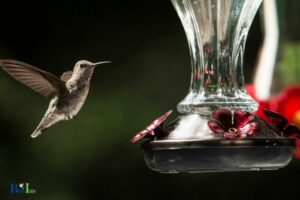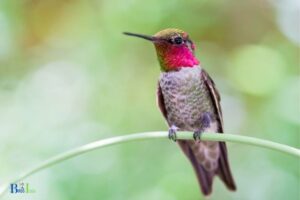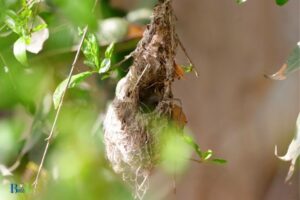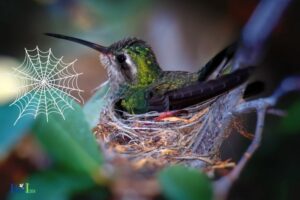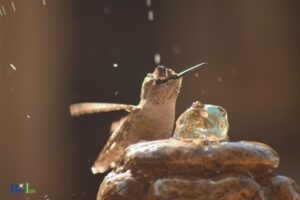How to Keep Ants off Hummingbird Pole? 7 Method!
To keep ants off your hummingbird pole, use an ant moat or apply a non-toxic substance to the pole to deter ants from climbing.
Ants are attracted to the sugar in hummingbird feeders, which can lead to infestations that are harmful to both hummingbirds and homeowners.
There are several methods to prevent ants from reaching the feeder, ensuring the safety and enjoyment of the hummingbirds.
Installing an ant moat is a popular and effective method for keeping ants away from your hummingbird feeder. An ant moat is a small cup or container filled with water that is placed above the feeder on the pole.
The ants, unable to cross the water, will be unable to reach the feeder. Alternatively, you can apply a non-toxic substance such as petroleum jelly or Tanglefoot to the pole, creating a slippery surface that ants cannot climb.
Additionally, using a slick or slippery pole material, like PVC or metal, can make it more difficult for ants to climb.
Finally, regularly cleaning and maintaining your hummingbird feeder will help prevent any leaks or spills that might attract ants in the first place.
7 Effective Method For Keeping Ants Off Hummingbird Poles
| Method | Description | Advantages | Disadvantages |
|---|---|---|---|
| Moats | Create a moat around the pole by using a cup or container filled with water. | Effective in stopping ants from reaching the hummingbird feeder. | May need frequent water refilling. |
| Ant Guards | Attach commercially available ant guards or baffles to the pole. | Easy to install and effective in stopping ants. | Can be expensive if multiple feeders are in use. |
| Grease or Oil | Apply a layer of grease or oil around the pole to make it slippery for ants. | Inexpensive and easy to apply. | Requires periodic reapplication. |
| Vaseline | Spread a layer of Vaseline around the pole. | Inexpensive and easily found. | May need to be reapplied often, might melt in hot temperatures. |
| Talcum Powder | Dust a layer of talcum powder around the pole. | Easily available and inexpensive, ants dislike the texture. | Requires periodic reapplication and might not be as effective in wet conditions. |
| Copper Tape | Wrap copper tape around the pole. | Ants dislike the sensation of walking on copper. | Might require replacement, not as effective when wet. |
| Borax | Sprinkle borax around the base of the pole. | Affects ants’ digestive system, can limit population growth. | Must be applied carefully, as it can be harmful to pets and other animals. |
Key Takeaway

Five Facts About Keeping Ants Away from Hummingbird Poles
Understanding The Ants: Why They Are Attracted To The Hummingbird Feeder
The Role Of Sugar: Why Ants Are Drawn To Your Hummingbird Feeder
The sugar in hummingbird nectar attracts ants to the feeder. To make nectar, most recipes use a mixture of white sugar and water, which is a perfect feast for ants.
Here are some key points to understand:
- Ants are attracted to sweet things and hummingbird nectar is no exception.
- Sugar is a primary ingredient in most nectars and is an excellent source of food for ants.
- Ants have a strong sense of smell and can detect even the slightest traces of sugar.
Ant’S Behaviour Patterns: How They Discover And Invade Your Feeder
Ants have an innate ability to track sources of food. They have a skilful talent for exploring their surroundings to find food, water, and shelter.
Here are some key points to learn how they find and invade your feeder:
- Ants have developed the ability to communicate with each other effectively through trails of pheromones leading to the discovered source of food.
- They follow the trail and find the sweet scent of the nectar in your feeder.
- They climb up the pole or the hanger, or crawl over any obstacles in search of the sweet nectar.
To keep ants away from your feeder, you need to take proactive measures. Clean the hummingbird feeder regularly with soapy water, never use pesticides or poisons, buy an ant moat, and apply vegetable oil on the pole.
By following these techniques, you can ensure the ants stay far away from your feeder, and your hummingbirds can enjoy the sweet delicacy in peace.
Simple Yet Effective Ways To Keep Ants Off Your Hummingbird Feeder
You might spend a lot of time setting up your hummingbird feeder. However, the moment you notice ants on your feeder, it’s enough to ruin your day.
These pesky insects can ruin the nectar, making it unappetizing for hummingbirds and even create mold, which could be hazardous to these tiny birds. To safeguard your feeder from ants, try these simple yet effective ways to keep them off.
Maintaining The Feeding Area Clean And Dry
One of the most effective ways to keep ants off your hummingbird feeder is to ensure that the feeding area is always clean and dry. By cleaning and emptying the feeder daily, ants won’t have a reason to swarm the site.
Here are some tips to guide you:
- Use warm soapy water to clean the feeder every time you replace the nectar.
- Rinse the feeder thoroughly after cleaning it.
- Dry the feeder completely before refilling it with nectar.
Using Ant Moats: Types, Installation, And Functionality
You can also use ant moats as an additional line of defense. Ant moats act as barriers that prevent ants from reaching the nectar.
Here’s a brief on ant moats:
- Ant moats can be of two types: Glass and plastic.
- Glass ant moats are much more durable than plastic ant moats.
- Ant moats can be installed above or below the feeder.
- To install an ant moat, hang it on top of the feeder or the hook that holds it.
Choosing The Right Ant-Proof Feeder Design: Important Features To Look Out For
Another effective way to keep ants off your hummingbird feeder is to opt for an ant-proof feeder. These feeders have features designed to keep ants at bay.
Here’s what you need to considering when choosing an ant-proof feeder:
- Select feeders with smooth surfaces and no gaps to prevent ants from crawling.
- Look for feeders with built-in ant moats.
- Choose feeders with an adjustable port size to control the flow of nectar, restricting its access to ants.
Homemade Ant Barriers: Diy Solutions
Lastly, you can create homemade ant barriers using readily available materials such as dish soap, petroleum jelly, or cooking spray.
Here’s how:
- Smear a thin layer of petroleum jelly or cooking spray on the feeder pole.
- Mix dish soap and water in equal measures, then use a spray bottle to apply the solution to the pole and any hanging parts of the feeder.
Keeping ants off your hummingbird feeder is essential to ensure these tiny birds get the nourishment they need. By following these simple yet effective ways, you can thwart these pesky insects effortlessly.
Expert Tips For Ant-Free Hummingbird Feeding Experience
Are you tired of ants invading your hummingbird feeder, making it difficult for your tiny feathered friends to enjoy their food?
Here are some expert tips to keep ants off your hummingbird pole and enjoy a pest-free feeding experience.
Using Natural Ant Repellants: Vinegar, Spices, And Essential Oils
- Vinegar is a natural ant repellent that can be diluted with water and sprayed on the ground below your hummingbird feeder.
- Spices such as cinnamon, cloves, and black pepper can also act as ant deterrents. Sprinkle them around your feeder, and ants will shy away.
- Essential oils such as peppermint, eucalyptus, or tea tree can be mixed with water and sprayed on the feeder’s surface to keep ants at bay.
Placing The Feeder In The Right Location: Avoiding Hotspots And Direct Sunlight
- Ants are attracted to warm and sunny areas. So, avoid placing your feeder under direct sunlight or in hot spots.
- Keep the feeder in a shady area, and ensure that it’s not located near any ant nests or colonies.
- Ants also use the overhead wires, branches, or poles to reach the feeder. Make sure to keep the feeder at least 10 feet away from any horizontal support.
Attracting Ant Eaters: Hummingbirds’ Natural Predators
- Ants are tiny creatures, and they are no match for your hummingbirds’ natural predators.
- Attract birds that feed on insects, like the black phoebe, to your garden by putting up perches and nest boxes.
- You can also include plants like california flannel bush, spicebush, and wild lilac to add an extra element of attraction.
Preventing Ants From Crossing Over: Oiling Thin Wires And Sheaths
- Ants cannot cross an oily surface. So, oiling thin wires and sheaths can prevent ants from crawling up to the feeder.
- Use a cotton ball and rub a small amount of vegetable oil on the wires or sheaths, making sure to avoid the feeder’s feeding ports.
- You can also try petroleum jelly instead of vegetable oil.
Keeping ants off your hummingbird feeder can be achieved by using natural ant repellents, positioning the feeder in the right location, attracting ant-eating birds, and preventing ants from crossing over using oiling techniques.
By following these expert tips, you can ensure that your hummingbirds enjoy a pest-free feeding experience.
Safety Precautions To Keep In Mind When Dealing With Ants
When it comes to keeping ants off hummingbird poles, it’s essential to follow safety precautions to protect not only yourself but also the hummingbirds that visit your feeder.
Here are some safe and practical measures you can take to keep ants off hummingbird poles:
Avoiding Harmful Chemicals: Safe And Eco-Friendly Alternatives
Using harmful chemicals to keep ants off the hummingbird pole can harm not just the birds but also the environment.
Here are some safe and eco-friendly alternatives to toxic chemicals that are effective in keeping ants off hummingbird poles.
- Apply a thick layer of petroleum jelly to the pole; ants can’t walk across it.
- Use a spice barrier. Ants don’t like cinnamon, black pepper, chili powder, and other spices. Mix these spices with water and spray the solution on the pole.
- Soak cotton balls in peppermint oil and place them around the pole. Ants hate the smell of peppermint.
Understanding The Risks Of Attracting Predators
Ants crawling on your hummingbird pole can attract predators such as wasps and other insects, which can harm the birds.
Here are some measures you can take to mitigate these risks:
- Keep the feeder away from bushes and shrubs where predators can hide.
- Plant hummingbird-friendly flowers away from the feeder to attract predators away from the birds.
- Clean up any spilled sugar water or nectar to avoid attracting unwanted pests.
Proper Cleaning Techniques: Health And Hygiene Considerations
Keeping your hummingbird feeder clean is essential to prevent the spread of diseases and bacteria.
Here are some health and hygiene measures you can take to maintain a clean hummingbird feeder:
- Clean the feeder every three to four days with hot, soapy water, then rinse it thoroughly.
- Use a small brush to clean the feeding ports and other hard-to-reach areas.
- Sterilize the feeder once a month by soaking it for 10 minutes in a solution of one part white vinegar to four parts water. Rinse the feeder thoroughly before refilling it.
Keeping ants off your hummingbird pole takes some effort, but the payoff is worth it to keep the birds safe and healthy.
By following these safety precautions and cleaning techniques, you can enjoy watching these beautiful birds without worrying about pesky ants.
FAQ About Keeping Ants Away from Hummingbird Poles
How Do Ants Get On Hummingbird Poles?
Can Ants Harm Hummingbirds Or Birdfeeders?
What Are Some Natural Ways To Repel Ants?
Can I Use Pesticides To Keep Ants Off Hummingbird Poles?
How Often Should I Clean My Hummingbird Feeder To Prevent Ants?
Conclusion
Ants are a common problem when it comes to feeding hummingbirds, but with the tips and tricks outlined above, it is possible to keep these pesky insects at bay.
Whether you opt for a specially designed ant moat, create a physical barrier, or simply change the location of your hummingbird feeder, there are plenty of solutions to explore.
By regularly cleaning your feeder and ensuring it is well-maintained, you can help to prevent ant infestations from starting in the first place. With a little effort, you can create a hummingbird-friendly environment that not only attracts these delightful birds, but also keeps ants away.
It’s all about taking a proactive approach, being persistent, and finding the solution that works best for you and your feathered friends. Happy hummingbird watching!

